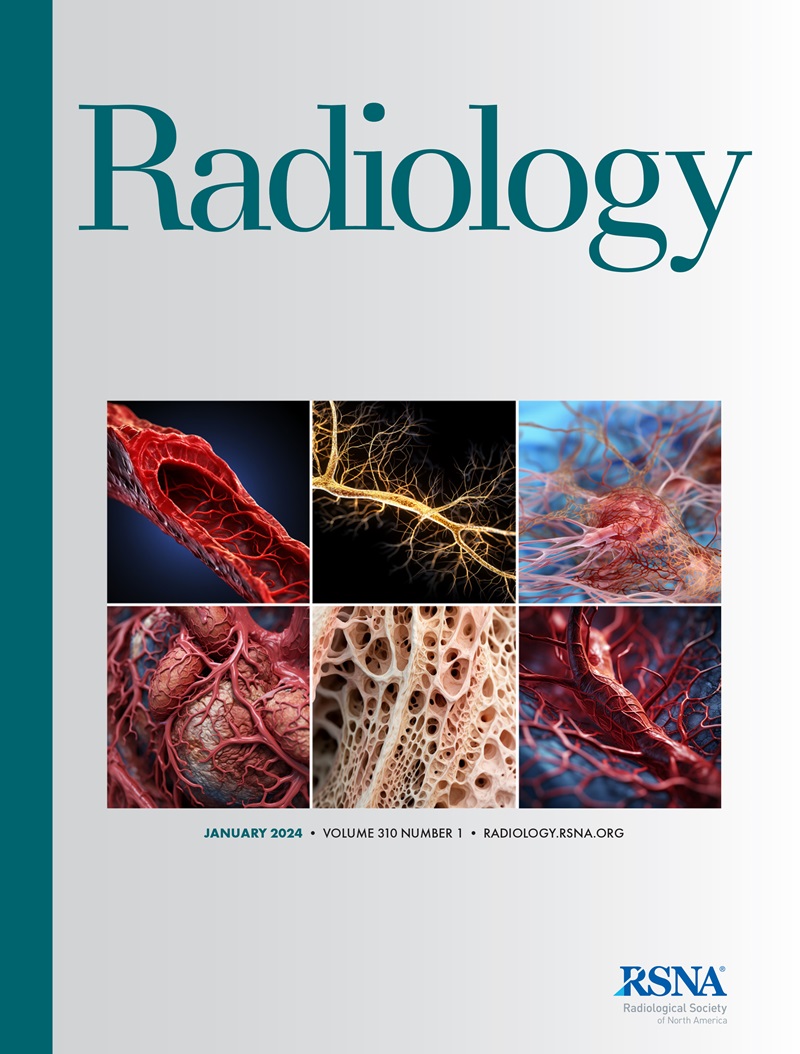LI-RADS CT和MRI辅助特征对诊断性能的影响:个体参与者数据荟萃分析。
IF 12.1
1区 医学
Q1 RADIOLOGY, NUCLEAR MEDICINE & MEDICAL IMAGING
引用次数: 0
摘要
最近的一项荟萃分析显示,大多数肝脏影像学报告和数据系统(LI-RADS)辅助特征(AFs)与肝细胞癌(HCC)、恶性和良性之间存在独立关联。然而,af对LI-RADS诊断性能的影响尚不清楚。目的通过个体参与者数据(IPD)荟萃分析,评估应用个体AFs对CT和MRI LI-RADS诊断性能的影响。材料和方法检索数据库,检索2014年1月至2023年2月发表的研究,这些研究使用2014、2017或2018版LI-RADS评估了CT和MRI对有HCC风险的成人HCC的诊断准确性。根据LI-RADS的主要特征对观察结果进行分类,可用时应用阈值增长,排除先前治疗或不符合综合参考标准(组织病理学分析或影像学)的观察结果。采用一步法,通过双变量混合效应模型汇总IPD,考虑参与者水平和研究水平随机效应的聚类。采用三种策略推导LI-RADS 1-5类的受试者操作特征曲线下面积(AUC)和LI-RADS 5类(LR-5)观测值的阳性预测值(PPV)、敏感性和特异性:(a)仅主要特征;(b)每个单独自动对焦应用的主要特征;(c)与策略2类似,但允许支持HCC或一般恶性肿瘤的AFs在出现时将LR-4类别升级为LR-5类别。采用双尾z检验进行比较。使用诊断准确性研究质量评估2评估偏倚风险。结果:46项研究包括9257项观察(1098次CT, 8159次MRI), 7811名成年参与者(6792名男性;平均年龄58.7岁±10.7 [SD])。对于所有AFs,策略1-3之间LI-RADS类别1-5的auc无差异(P值范围为0.65 ~ 0.99)。对于LR-5类,策略1-3在PPV、敏感性和特异性方面也没有差异(P值范围为0.11至0.99)。只有低风险偏倚研究的敏感性分析(46项研究中的9项)得出的结果与初步分析一致。结论与单独使用主要特征相比,单个AFs的应用对CT和MRI LI-RADS的整体诊断性能没有影响。©RSNA, 2025本文可获得补充材料。参见Searleman在本期的社论。本文章由计算机程序翻译,如有差异,请以英文原文为准。
Impact of LI-RADS CT and MRI Ancillary Features on Diagnostic Performance: An Individual Participant Data Meta-Analysis.
Background A recent meta-analysis showed independent associations between most Liver Imaging Reporting and Data System (LI-RADS) ancillary features (AFs) and hepatocellular carcinoma (HCC), malignancy, and benignity. However, the impact of AFs on the diagnostic performance of LI-RADS remains unclear. Purpose To evaluate the impact of applying individual AFs on the diagnostic performance of CT and MRI LI-RADS using an individual participant data (IPD) meta-analysis. Materials and Methods Databases were searched for studies published from January 2014 to February 2023 that evaluated the diagnostic accuracy of CT and MRI for HCC in adults at risk for HCC using LI-RADS version 2014, 2017, or 2018. Observations were categorized according to LI-RADS major features, applying threshold growth when available, and excluding those previously treated or not meeting the composite reference standard (histopathologic analysis or imaging). Using a one-step approach, the IPD were pooled via bivariate mixed-effects models, accounting for clustering in participant-level and study-level random effects. The area under the receiver operator characteristic curve (AUC) for LI-RADS categories 1-5 and the positive predictive value (PPV), sensitivity, and specificity for LI-RADS category 5 (LR-5) observations were derived using three strategies: (a) major features only; (b) major features with each individual AF applied; and (c) similar to strategy 2 but allowing AFs favoring HCC in particular or malignancy in general to upgrade category LR-4 to category LR-5 when present. Comparisons were made using two-tailed z tests. Risk of bias was assessed using Quality Assessment of Diagnostic Accuracy Studies 2. Results Forty-six studies comprising 9257 observations (1098 CT, 8159 MRI) in 7811 adult participants (6792 male; mean age, 58.7 years ± 10.7 [SD]) were included. For all AFs, there were no differences in AUCs of LI-RADS categories 1-5 among strategies 1-3 (P value range, .65 to >.99). For category LR-5, there were also no differences among strategies 1-3 in the PPV, sensitivity, and specificity (P value range, .11 to >.99). Sensitivity analysis of only low-risk bias studies (nine of 46) yielded results consistent with primary analysis. Conclusion The application of individual AFs did not impact the overall diagnostic performance of CT and MRI LI-RADS compared with major features alone. © RSNA, 2025 Supplemental material is available for this article. See also the editorial by Searleman in this issue.
求助全文
通过发布文献求助,成功后即可免费获取论文全文。
去求助
来源期刊

Radiology
医学-核医学
CiteScore
35.20
自引率
3.00%
发文量
596
审稿时长
3.6 months
期刊介绍:
Published regularly since 1923 by the Radiological Society of North America (RSNA), Radiology has long been recognized as the authoritative reference for the most current, clinically relevant and highest quality research in the field of radiology. Each month the journal publishes approximately 240 pages of peer-reviewed original research, authoritative reviews, well-balanced commentary on significant articles, and expert opinion on new techniques and technologies.
Radiology publishes cutting edge and impactful imaging research articles in radiology and medical imaging in order to help improve human health.
 求助内容:
求助内容: 应助结果提醒方式:
应助结果提醒方式:


